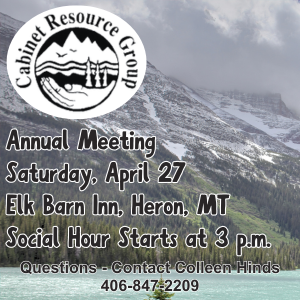Remember When?
August 13, 2020
THE HISTORY OF
THOMPSON FALLS
BY RUTH HARLOW
WRITTEN FEBRUARY 4, 1954
Author’s Note: This information was received from Mr. W.A. Barto, a long-time resident of Thompson Falls.
Thompson Falls was named after David Thompson, who explored the territory of western Montana and parts of Canada. The first wooden roofed house to be built in Montana was the Salish House, which was a fur trading post in 1809. It was located on the south side of the river, about directly opposite of David Thompson’s Monument, east of town.
Thompson Falls was originally, and still is a lumbering town. The first railroad station was located east of town on the Woodlin Flats. The depot was about twice the size it is now because supplies were shipped here and then sent by pack trains to the north and to Wallace, Idaho. The first start of the town was when the mines opened up in Idaho, and this was used as a shipping point. Goods were packed over a toll road to Wallace.
The first start of the town consisted of a saloon, near the east edge of the present town; the depot, on the Woodlin Flats; and a sawmill, near where Huffman’s live (Harlow Road). They piped water from Weber Creek for the sawmill, and deer and wild animals were always knocking out the troughs, through which the water ran.
By 1906, the town extended from the Peek Building (site of True Value) north and east. In 1905, the first bank was started by Mr. Reed, Mr. Harlen, and Mr. William Allen Barto. Mr. Barto was the first president, this bank was the First State Bank, which later became First Security Bank. The first bank was located in the building where Saint’s Service Station (now Genki Café) is now. The bank was the third office from the corner. The vault was made of bricks with the door of steel bolted together. They didn’t want to pay the high price of a boughten vault door, so they made their own, and bolted it shut every night because they had no hinges.
In 1908 there was a fire that destroyed the bank and that whole block, but all the papers and money were saved because they were in the vault.
In 1900 the Forest Service consisted of Mr. Silcox. His office was a room over Weber’s Store (now the laundromat).
When the 1910 fire broke out, the Forest Service had no facilities for fire fighting, and they couldn’t hold their men because of the way they paid them. The men would file a claim for their money and send it to the Thompson Falls Forest Service. Then, they would send it to Missoula, and in about 10 days they got a check.
Since the Forest Service couldn’t hold any men because of the payment system, the bank loaned the Forest Service $4,000. They would pay the men with this money and when they had collected about $3,000 worth of claims they would send them into Missoula and pay the bank back when they got their money.
After the bank was destroyed by fire, the bank had its office in the Assessors office in the courthouse for six months and in the Commissioner’s room the rest of the time. The Assessor, though he was paid for 12 months work, worked only about six. The Commissioners met only about three days a month.
There have been three Thompson Falls – one at Belknap, one on the Woodlin Flats, and one at Thompson Falls. But since the ferry crossed the river here, the town was moved to its present site.
Sanders County was originally a part of Missoula County. In 1905, Edward Donlan, a senator from Missoula, and Mr. J.A. McGowan, a representative in the legislature, formed the county of Sanders.
The temporary county seat was at Thompson Falls. McGowan, who was for Plains as the county seat, named the first officers. They were all from Plains. Donlan was for Thompson Falls. The permanent seat was decided by an election. Thompson Falls won. After the place was decided, they needed a courthouse. Doenges agreed to put up a building if he could get cheap lumber. Donlan, put up a building on Preston Avenue between Spruce and Cedar Streets. The commissioners rented it for several years while the courthouse was being built.
The limit of indebtedness which the commissioners could incur was $10,000. So, they had to build a courthouse for less than $10,000. Donlan gave the county the land for the courthouse to be built on, and provided cheap lumber again. The cost of the building was $9,995.
In 1912, the dam was started. Balkan peoples were brought over for workers on the dams. The Balkan people were usually fighting among themselves in the old country, but over here they were all right until about 1914, when the Balkan countries got into a larger war than usual.
The workers lived mostly in tent houses which were located where the power company houses are now (west end of Maiden Lane). The dining room was run by Mr. Hoyt and Mr. Macho was the cook.
The first Auto Agency was located by the river. The first Ford Agency was started by Jacks and Momberg. It was located where Artistic Image styling salon now is. They sold out to Woodson and Heater, Woodson sold out to Heater and he moved it to the east end of the block (now a parking lot). The first car that stayed here was bought by Walter Morkert.
The first school was located on the corner of Preston Avenue and Ferry Street (it still stands, but has been added onto and is now an apartment building). The first dormitory was where the Pastime Bar is (Highlead Saloon). The first teacher was Mr. W.R. Nippert. He was usually drunk and had very poor eyesight. The pupils used to bring animals to school and Mr. Nippert would think he was seeing things and going crazy, so he would send all the pupils home for the rest of the day. In this way the pupils got lots of holidays.




Reader Comments(0)